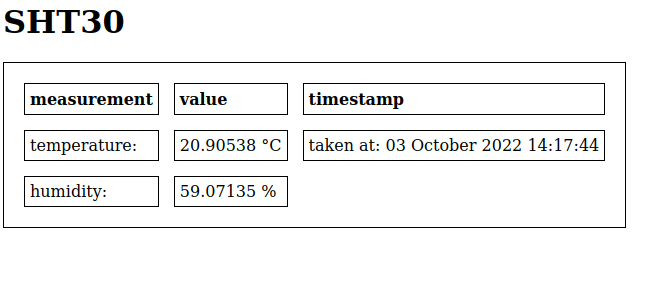A WEB Server and the HTTP Protocol
Exercise 1: Write a Hello World WEB Server
Write a simplistic WEB server, serving a single WEB page. This server is very similar to the TCP server written in the [WiFi]] exercises. It now waits for a connection on port 80, reads a request from the browser, and sends a simple HTML page as its response. Interpretation of the incoming request is not necessary because the server is only capable of sending a single page anyway. Print the incoming HTTP request, which will look similar to this: The request starts with "Content Get / HTTP/1.1"
The page seen by the browser will look similar to this:
The request starts with "Content Get / HTTP/1.1"
The page seen by the browser will look similar to this:

Exercise 2: picoweb
Download picoweb and its example programms from gitthub: https://github.com/pfalcon/picoweb.- https://www.dfrobot.com/blog-742.html

- https://techtutorialsx.com/2017/09/01/esp32-micropython-http-webserver-with-picoweb

 For more information on the use of picoweb you will have to study the examples distributed with the github repository or picoweb itself. The examples demonstrate most of picoweb's features.
Re-write the example from exercise 1 using the picoweb framework. Now the HTML page is separated from the code and must be stored in a separate file. Upload this file to the ESP32 into a folder named html. Create the folder if it does not exist yet. You may also compress the HTML file with gzip and transfer the compressed file to the browser thus limiting the size of the message that must be sent.
For more information on the use of picoweb you will have to study the examples distributed with the github repository or picoweb itself. The examples demonstrate most of picoweb's features.
Re-write the example from exercise 1 using the picoweb framework. Now the HTML page is separated from the code and must be stored in a separate file. Upload this file to the ESP32 into a folder named html. Create the folder if it does not exist yet. You may also compress the HTML file with gzip and transfer the compressed file to the browser thus limiting the size of the message that must be sent.
Exercise 3: Provide Measurement Data on the WEB Page
Modify the WEB server to provide temperature and humidity measured with the SHT30. The easiest way to accomplish this is static text like in the Hello World HTML page into which the measurements can be inserted. This can be done with utemplates
Exercise 4: Ajax
The above exercise has a major flaw: For each measurement you must reload the entire page. It would be much nicer it the WEB page could be updated whenever a new is requested. --Comments
| I | Attachment | History | Action | Size | Date | Who | Comment |
|---|---|---|---|---|---|---|---|
| |
helloWorldWebServerV1.png | r1 | manage | 38.8 K | 2022-10-03 - 08:22 | UliRaich | |
| |
http.png | r1 | manage | 105.1 K | 2022-10-03 - 08:17 | UliRaich | |
| |
picowebInstallation.png | r1 | manage | 13.3 K | 2022-10-03 - 09:57 | UliRaich | |
| |
sht30WebSite.png | r1 | manage | 15.5 K | 2020-05-27 - 19:53 | UliRaich |
Ideas, requests, problems regarding TWiki? Send feedback



